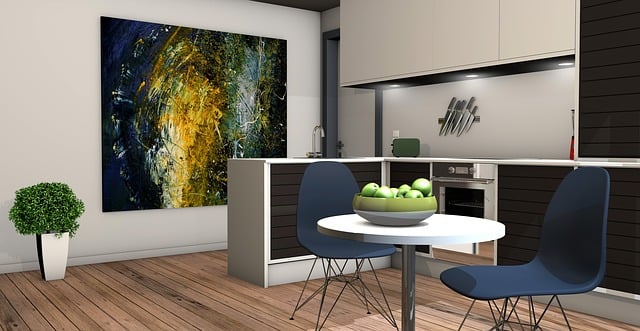Hardwood floors are a popular and timeless choice for kitchens due to their classic aesthetic, durability, warmth, and resistance to heavy foot traffic and scratches. They offer diverse species and finishes, are eco-friendly, and last for generations. While tile, vinyl, laminate, bamboo, and cork provide alternative kitchen flooring options with unique benefits like waterproofing and sustainability, hardwood remains a top pick for its versatility and low maintenance.
When designing a kitchen, choosing the right flooring can be a daunting task. But fear not! This guide offers a comprehensive exploration of timeless flooring materials to suit any style and budget. From classic hardwood to modern tile and sustainable alternatives, we delve into the pros and cons of various options. Discover the ultimate solutions for your dream kitchen, whether you’re after durability, aesthetics, or eco-friendliness. Uncover the perfect balance between form and function with these enduring flooring choices.
- Timeless Hardwood Kitchen Floors
- – Advantages of hardwood floors in kitchens
- – Types of hardwood suitable for kitchen environments
- – Installation and maintenance tips
Timeless Hardwood Kitchen Floors
When it comes to choosing kitchen flooring that stands the test of time, hardwood floors are an excellent and versatile option. They offer a classic aesthetic that complements various design styles, from traditional to modern. Hardwood is a popular choice among homeowners and designers alike due to its natural beauty, warmth, and durability. This timeless material can endure heavy foot traffic and is highly resistant to scratches, making it perfect for the high-wear areas of a kitchen.
Available in a wide array of species and finishes, hardwood floors can be tailored to suit any taste and budget. From robust oak and walnut to exotics like teak or maple, each wood type has its unique characteristics and grain patterns. Moreover, hardwood is an eco-friendly choice as it is renewable and recyclable, contributing to a more sustainable kitchen environment. With proper care and maintenance, these floors can last for generations, ensuring your kitchen stays stylish and functional over time, regardless of the trending flooring options in the market, including durable tile, vinyl, or laminate alternatives that may not offer the same level of longevity and aesthetic appeal.
– Advantages of hardwood floors in kitchens
Hardwood floors offer a timeless and elegant option for any kitchen design. One of their primary advantages is durability; they can withstand heavy foot traffic, making them ideal for high-use spaces like kitchens. Hardwood also provides an unparalleled aesthetic appeal with its natural grain patterns and warmth, complementing both modern and traditional decor styles. Furthermore, hardwood floors are eco-friendly, as they are made from renewable resources and can be refinished multiple times, extending their lifespan.
Compared to other kitchen flooring options like tile or vinyl, hardwood offers superior comfort underfoot and better sound insulation. They are also versatile in terms of maintenance; with regular cleaning and polishing, hardwood floors can remain in pristine condition for years. Additionally, waterproof finishes make them suitable for kitchens, addressing a key concern for many homeowners. This combination of aesthetics, durability, and functionality makes hardwood kitchen floors a popular choice among those seeking both style and substance.
– Types of hardwood suitable for kitchen environments
When it comes to choosing floor materials for your kitchen, durability and functionality should top your list, as this high-traffic area requires a robust option that can withstand daily wear and tear. Hardwood is an excellent choice for those seeking both beauty and sturdiness. Opting for species like oak, maple, or walnut provides not only a timeless aesthetic but also a natural resistance to water and stains. These hardwares are easy to maintain and clean, making them ideal for kitchens.
Beyond traditional hardwood, various other kitchen flooring options cater to different preferences and budgets. Tile flooring, for instance, offers a wide array of designs, colours, and textures, making it versatile and suitable for both modern and classic kitchens. Vinyl and laminate floors are popular choices due to their affordability and water-resistant properties, ideal for kitchens with potential spillage or moisture issues. For eco-conscious homeowners, there’s an increasing range of sustainable options, including bamboo and engineered hardwoods, providing durability and an environmentally friendly approach to modern kitchen floor materials.
– Installation and maintenance tips
When considering timeless flooring materials for your kitchen design, keep in mind that proper installation and maintenance are key to ensuring longevity and aesthetic appeal. For durable kitchen flooring, tile and hardwood kitchen floors top the list due to their resilience and ability to withstand heavy foot traffic. These options require minimal maintenance; a simple mopping or vacuuming routine is usually sufficient, with occasional deep cleaning for stubborn stains.
For those seeking modern kitchen floor materials that are also waterproof, vinyl kitchen flooring and laminate kitchen flooring offer excellent choices. Vinyl is highly versatile and can mimic the look of tile or hardwood, while laminate provides a natural wood appearance without the maintenance. Both require little to no sealing or polishing, making them low-maintenance options. When it comes to eco-friendly kitchen floors, consider materials like bamboo or cork, which are sustainable alternatives to traditional hardwoods, offering both durability and a unique aesthetic appeal.
When it comes to choosing a floor for your kitchen, opting for timeless and durable materials can elevate the space’s aesthetic appeal and functionality. Hardwood, vinyl, or laminate floors offer a range of benefits, from natural elegance to low maintenance, catering to various preferences and lifestyles. Each option provides a solid foundation for any design theme, whether modern or traditional. Remember, selecting the right kitchen flooring materials can make a significant difference in creating a comfortable, stylish, and practical cooking environment.
